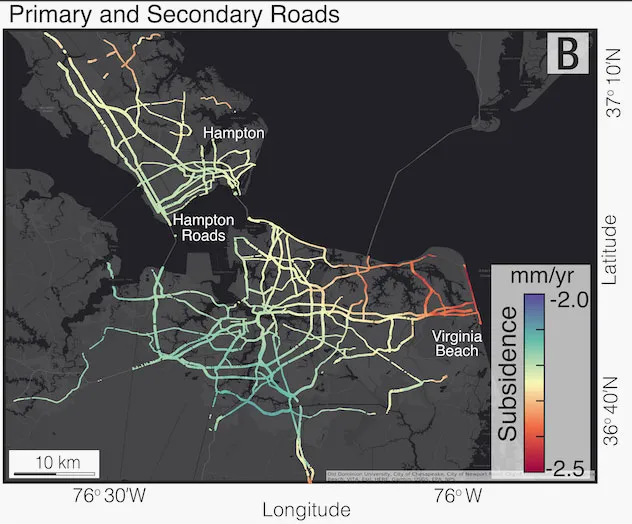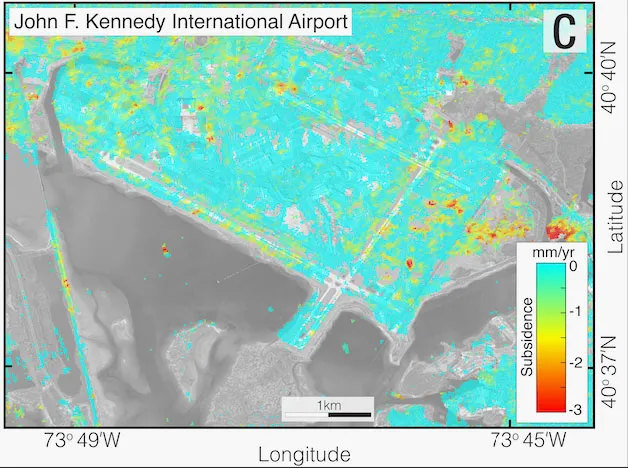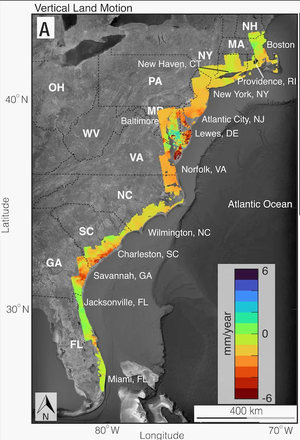'The impacts are real': New satellite images show East Coast sinking faster than we thought

New satellite images show the eastern U.S. coast is sinking at a faster rate than what was first reported last year, according to a new study published in the journal PNAS Nexus.
Back in September, a team of scientists out of Southern California found that the New York City metro area is sinking at an average of 0.06 inches annually, USA TODAY previously reported. That number is now 0.08 inches in some areas, according to the new study published on Jan. 2.
"The problem is not just that the land is sinking. The problem is that the hotspots of sinking land intersect directly with population and infrastructure hubs," according to a statement from lead author Leonard Ohenhen, a graduate student working with associate professor Manoochehr Shirzaei at Virginia Tech’s Earth Observation and Innovation Lab.
Ohenhen, Shirzaei and colleagues from the Earth Observation and Innovation Lab at Virginia Tech measured "vertical land motion rates" obtained from space-based radar satellites "to evaluate the subsidence-hazard exposure to population, assets, and infrastructure systems/facilities" along the East Coast, according to the study.
The maps of the terrain are the first of their kind.
The new research is "extremely valuable," Patrick Barnard, a research geologist with the U.S .Geological Survey and a co-author of the study, said in a statement.
"This information is needed," he said. "No one else is providing it."
Is New York City sinking?NASA finds metropolitan area slowly submerging
Infrastructure like airports at risk

The hotspots of sinking land referenced by Ohenen include "significant areas of critical infrastructure in New York, including JFK and LaGuardia airports and its runways, along with the railway systems," he said, adding that they're sinking by a rate of more than 2 mm a year.
Receding around these hotspots could bring damage to infrastructure and make the land more vulnerable to flooding.
“Even if that is just a few millimeters per year, you can potentially cause cracks along structures,” Ohenhen said.
In New York City, five million people and 1.8 million properties are at risk, according to the study.
New York City is sinking, study says:Huge buildings, rising seas contribute to subsidence
Spots of Atlantic Coast sinking more than 0.2 inches annually
Satellite measurements from the study show that on top of the 74,000 square kilometers (29,000 square miles) of the Atlantic Coast losing 2 millimeters (0.08 inches) a year, over 3,700 square kilometers along the Atlantic Coast are losing more than 5 millimeters (0.2 inches) a year.
With the sea level rising 10 to 14 inches in the next three decades along the East Coast, this makes for what seems to be an inescapable situation.
But "it’s not just about sea levels,” Ohenhen said. “You also have potential to disrupt the topography of the land, for example, so you have areas that can get full of flooding when it rains.”

The new study mentions that some solutions, like the raising of levees, may not be possible because not all areas of land are sinking at the same rate.
“If you have a building or a runway or something that’s settling uniformly, it’s probably not that big a deal,” Tom Parsons, a geophysicist with the United States Geological Survey, told Wired. “But if you have one end that’s sinking faster than the other, then you start to distort things.”
Other hotspots from the study include Virginia Beach, where 451,000 people and 177,000 properties are at risk, and Baltimore, Maryland, where 826,000 people and 335,000 properties are at risk.
"Through this study, we highlight that sinking of the land is not an intangible threat," Shirzaei said. "It affects you and I and everyone. It may be gradual, but the impacts are real."
Read the full study here.

Disclaimer: The copyright of this article belongs to the original author. Reposting this article is solely for the purpose of information dissemination and does not constitute any investment advice. If there is any infringement, please contact us immediately. We will make corrections or deletions as necessary. Thank you.






